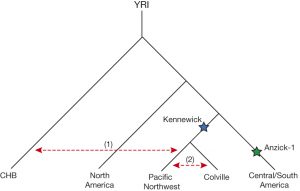In 1996, near Kennewick, WA, two college students accidentally discovered remains that were later estimated to be over 9,000 years old. Today, Native Americans refer to the individual as The Ancient One (Fabry, 2016). According to Bonnichsen v. US, in 2004, Native Americans could not prove the necessary affiliation to modern day tribes in court for the remains to be repatriated under NAGPRA (Bonnichsen v. United States, 2004). However, The Ancient One was recently repatriated this year by an act of Congress after new DNA evidence proved otherwise (Clarridge, 2016). One reason that the court system failed Native Americans for about 20 years is that oral tradition was not seen as reliable evidence in court (Fielding, 2013). The treatment of this evidence in Bonnichsen v. US demonstrates one way in which the US legal system is biased against Native American ways of knowing.

http://www.smithsonianmag.com/history/kennewick-man-finally-freed-share-his-secrets-180952462/
Oral tradition should be valued by both museums and courts during the repatriation process. Native Americans should be considered experts on their own cultures because of their lived experiences. Having been raised in a culture should qualify them as experts beyond what another person can learn in school, and if that culture includes oral traditions, they should be accepted. However, even if courts want to evaluate evidence only by Western standards, oral evidence should be admissible because it is reliable. Many anthropologists accept oral stories from Native Americans because it can be stronger than written evidence (Fielding, 2013, 297). Furthermore, oral tradition is supported by written records in many cases (Fielding, 2013, 304). Oral tradition therefore has both a moral and scientific basis to be persuasive in court.

http://www.nature.com/nature/journal/vnfv/ncurrent/fig_tab/nature14625_F3.html
Still, oral tradition was rejected as evidence in the Bonnichsen v. US case, illustrating how the legal system prioritizes Western ideals. In Bonnichsen, the Ninth Circuit Court of Appeals determined, “…Because the value of [oral] accounts is limited by concerns of authenticity, reliability, and accuracy… we do not think that the oral traditions… were adequate to show the required significant relationship of the Kennewick Man’s remains to the Tribal Claimants” (Bonnichsen v. United States, 2004). An affidavit submitted by Dr. Andrei Simic, an anthropologist at USC, similarly concluded, “As a general rule, folklore and oral tradition are not stable enough to be taken as inherently accurate witnesses of events from the remote past” (Simic Aff. 3, 2000). In court, there was bias against Native American evidence. The court elevated the testimonies based on Western models, such as inaccurate craniometric analyses (Routledge, 2008), over others. In this way, the Kennewick Man reinforced the narrative that in the US legal system, science can be prioritized over culture.
Repatriation should be a way for healing, but during legal battles, wounds remain open. Oral tradition is just one way in which judges will favor scientists who aim to study the remains. The focus on Western science continues to privilege scientists in repatriation, when its goal should be to yield justice for Native Americans.
For the full court decision, click here:
http://caselaw.findlaw.com/us-9th-circuit/1420091.html
For the new DNA evidence, click here.
http://www.nature.com/nature/journal/vnfv/ncurrent/full/nature14625.html
Works Cited
Bonnichsen v. United States, 357 F.3d 962, U.S. App. (2004).
Clarridge, C. (2016, December 10). Legislation enables transfer of Kennewick Man to tribes. Seattle Times. Retrieved from http://www.seattletimes.com/seattle-news/politics/legislative-enables-transfer-of-kennewick-man-to-the-tribes/
Fabry, M. (2016, July 28).Where Kennewick Man Stands, 20 Years After Discovery. Time. Retrieved from http://time.com/4417295/kennewick-man-20-years/
Fielding, T. S. (2013). Evidence issues in Indian Law Cases. American Indian Law Journal, 1(2): 285-308.
Hamilton, M. D. (2008) “Colonizing America: PaleoAmericans in the New World.” In Kennewick Man: Perspectives on the Ancient One by H. Burke, C. Smith, D. Lippert, J. Watkins, and L. Zimmerman (Eds.). Walnut Creek, California: Routledge.
Simic, A. (2000). Affidavits Address Oral Tradition and Cultural Affiliation. Friends of America’s Past. Retrieved from http://www.friendsofpast.org/kennewick-man/court/affidavits/oral-tradition-5.html
